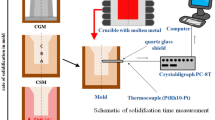Abstract
Understanding the relationship between solidification rate and thermal conductivity can enable the functional design of advanced industrial components. In addition to microstructural coarsening, decreasing solidification rate typically increases casting porosity. Despite its potential detriment to material properties, porosity has been inadequately considered in conductivity investigations involving varied solidification rates. Consequently, conflicting and potentially misleading results are present in the literature. Accordingly, in this study, the effects of porosity on the as-cast thermal conductivity of unmodified B319 aluminium alloy were isolated from the effects of microstructural refinement. This was done by extracting samples from various locations along a series of castings, each with individual solidification rates from 3.31°C/s to 0.104°C/s. Thermal conductivity was found to be relatively unaffected by microstructural coarsening, yet it was significantly reduced by the increase in porosity associated with decreasing solidification rate. Hence, dendritic refinement is not an effective technique to enhance this alloy’s thermal conductivity.






Similar content being viewed by others
References
W. Callister and G. Rethwisch, Materials Science and Engineering: An Introduction, 9th ed. (Hoboken: Wiley, 2013).
E. Vandersluis and C. Ravindran, J. Mater. Sci. 27, 1109 (2018).
E. Vandersluis, A. Lombardi, C. Ravindran, A. Bois-Brochu, F. Chiesa, and R. MacKay, Mater. Sci. Eng. A 648, 401 (2015).
C. Vázquez-López, A. Calderón, M. Rodriguez, E. Velasco, S. Cano, R. Colás, and S. Valtierra, J. Mater. Res. 15, 85 (2000).
D. Argo, R. Drew, and J. Gruzleski, AFS Trans. 95, 455 (1987).
K. Narayan Prabhu and B. Ravishankar, Mater. Sci. Eng. A 360, 293 (2003).
H. Oger, B. Closset, and J. Gruzleski, AFS Trans. 91, 17 (1983).
J. Davis, eds., ASM Specialty Handbook: Aluminum and aluminum alloys (ASM International: Materials Park, OH, 1993).
A. Manzano Ramirez, F. Espinoza Beltran, J. Yanez-Limon, Y. Vorobiev, and J. Gonzalez-Hernandez, J. Mater. Res. 14, 3901 (1999).
S. Bakhtiyarov and R. Overfelt, Mater. Sci. Technol. 20, 790 (2004).
E. Vandersluis and C. Ravindran, Trans. Indian Inst. Met. 71, 1231 (2018).
E. Vandersluis and C. Ravindran, J. Mater. Eng. Perform. 27, 1109 (2018).
E. Vandersluis and C. Ravindran, Metallogr. Microstruct. Anal. 6, 89 (2017).
S. Gustafsson, Rev. Sci. Instrum. 62, 797 (1991).
T. Log and S. Gustafsson, Fire Mater. 19, 43 (1995).
Acknowledgements
The authors are thankful to the Natural Sciences and Engineering Research Council of Canada (NSERC) for financial support of this project and for the award of the Canada Graduate Scholarship to Eli Vandersluis (Grant No. CGSD3-489708-2016). The authors are grateful to Alan Machin, Payam Emadi, Bernoulli Andilab, and the members of the Centre for Near-net-shape Processing of Materials (CNPM) at Ryerson University for experimental assistance and support.
Author information
Authors and Affiliations
Corresponding author
Ethics declarations
Conflict of interest
The authors declare that they have no conflict of interest.
Additional information
Publisher's Note
Springer Nature remains neutral with regard to jurisdictional claims in published maps and institutional affiliations.
Rights and permissions
About this article
Cite this article
Vandersluis, E., Ravindran, C. The Role of Porosity in Reducing the Thermal Conductivity of B319 Al Alloy with Decreasing Solidification Rate. JOM 71, 2072–2077 (2019). https://doi.org/10.1007/s11837-019-03376-0
Received:
Accepted:
Published:
Issue Date:
DOI: https://doi.org/10.1007/s11837-019-03376-0




